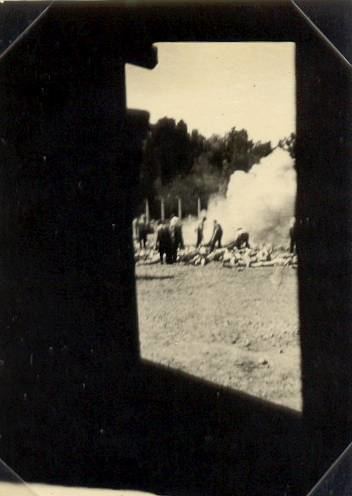Name Alberto Errera | Role Armed force officer | |
 | ||
Died August 1944, Oswiecim, Poland | ||
Sonderkommando Auschwitz Alberto Errera Part 4
Alberto Israel Errera (Greek: Αλβέρτος Ερρέρα, born 15 January 1913 in Larissa and died in August 1944 in Birkenau) was a Greek-Jewish officer and a member of the anti-Nazi resistance. He was a member of the Sonderkommando in Auschwitz-Birkenau from May to August 1944.
Contents
- Sonderkommando Auschwitz Alberto Errera Part 4
- Alberto Errera photograph 280 Sonderkommando Auschwitz
- Biography
- The Sonderkommando photographs
- References

He took part in the preparation of the Sonderkommando Uprising of 1944. He is one of the possible authors of the Sonderkommando photographs.
Alberto Errera photograph 280 Sonderkommando Auschwitz
Biography
Before the war, Alberto Errera was a soldier in the Hellenic Army, promoted to officer and achieving the rank of captain. He joined the partisans during the German occupation of Greece. He took the Christian name Alex (Alekos) Michaelides. On the night of 24 March 1944, he was arrested by the Germans in Larissa, part of a group of 225 Jews, and then jailed in the Haidari camp. He was deported from Athens on 2 April and arrived at Auschwitz on 11 April, at which point he was one of the 320 Greek (assigned serial numbers from 182,440 to 182,759) selected for labor. His number was 182,552. He was assigned the job of a Heizer, a member of the Sonderkommando assigned to the crematorium furnace) in Birkenau Krematorium V. Alter Fajnzylberg talks about his athletic build and Leon Cohen describes his unusual strength. According to Filip Müller, Leon Cohen and the historian and fellow prisoner Hermann Langbein, who actively participated in the preparations for the Sonderkommando Uprising, alongside Yaacov Kaminski, Jankiel Handelsmann, Jukl Wrobel, Josef Warszawski, a man named Wladek, Giuseppe Baruch and Zalman Gradowski, among others.
Through the testimony of Alter Fajnzylberg, we know that it was Errera who took the famous "Sonderkommando photographs", with the help of Dawid Szmulewski, a member of the resistance, and three other members of the Sonderkommando, Szlama Dragon, his brother and Alter Fajnzylberg, who kept watch. After taking the photographs, Errera buried the camera in the soil at the camp, for retrieval/discovery later.
On 9 August 1944, during the transport from the crematoria of ash that was to be discharged into the Vistula, Errera tried to convince his three co-detainees (including Hugo Baruch Venezia and Henri Nechama Capon) to escape, but they refused. Once on site, Errera stunned the accompanying two Schupos with a shovel and plunged into the Vistula. He was caught during the next two or three days, tortured and killed. As was usual, when a fugitive was caught, his body was exposed at the camp entrance as an example to the other inmates.
The Sonderkommando photographs
For many years, the author of the Sonderkommando pictures was not identified. They were credited as anonymous or, by default, assigned to Dawid Szmulewski, even if he mentioned a Greek Jew named Alex. The story of these photos was recorded by Alter Fajnzylberg in his writings in which he evokes the figure of the Greek Jew named Alex (although he forgot the surname). In May 1978, Fajnzylberg answered a letter from the Auschwitz-Birkenau Museum, about the photographs. He wrote:
However, in his diaries, written immediately after the war, Fajnzylberg mentions the attempted escape of a Greek Jew named Aleko Errera. His escape struck their minds and was told by several surviving witnesses: Errikos Sevillias, Shlomo Venezia, Leon Cohen, Marcel Nadjary, Dr. Miklos Nyiszli, Alter Fajnzylberg, Henryk Mandelbaum, Albert Menasche and Daniel Bennahmias.
